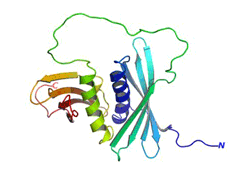
| Serial No. | GA-P0037HU |
| Species | Human |
| Specification | 0.1 mg/0.2mg |
| Brand | GenAsia |
| Origin | Shanghai |
| Price | US$350/US$620 |
Detailed information
1 Host: Escherichia coli (E. coli)
2 Species: Human
3 Protein Type: Recombinant
4 Synonyms: CD295, LEP-R, LEPRD, OB-R, OBR, LEPR, OB-RGRP, Obrgrp, VPS55, Fa, LEPROT, Leprb, Modb1, Obr, db, diabetes, obese-like, obl, ObRb, Ob-R, Ob-RM, obr, cd295, ob-rb
5 Purity: 95% by SDS-PAGE
6 Application: WB、 Elisa、 Functional Studies
7 Background:
Leptin Binding Domain Human Recombinant also called Leptin soluble receptor produced in E.Coli is a single, non-glycosylated, polypeptide chain containing 208 amino acids and having a molecular mass of 24.5 kDa. Leptin Receptor consists of the cytokine binding domain of leptin receptor amino acids 428-635 of human leptin receptor. The Leptin Binding Domain is purified by proprietary chromatographic techniques.
8 Storage&Stability:
Avoid repeated freeze and thaw cycle.Store at 2-8℃ for delivery and store at -20 or -70℃ for future use. The loss rate of the target protein which describes the stability was determined by accelerated thermal degradation test.That is to incubate the protein at 37℃ for 48h and no obvious degradation and precipitation were observed.The loss of this protein is less than 5% within the expiration date under appropriate storage condition.
2 Species: Human
3 Protein Type: Recombinant
4 Synonyms: CD295, LEP-R, LEPRD, OB-R, OBR, LEPR, OB-RGRP, Obrgrp, VPS55, Fa, LEPROT, Leprb, Modb1, Obr, db, diabetes, obese-like, obl, ObRb, Ob-R, Ob-RM, obr, cd295, ob-rb
5 Purity: 95% by SDS-PAGE
6 Application: WB、 Elisa、 Functional Studies
7 Background:
Leptin Binding Domain Human Recombinant also called Leptin soluble receptor produced in E.Coli is a single, non-glycosylated, polypeptide chain containing 208 amino acids and having a molecular mass of 24.5 kDa. Leptin Receptor consists of the cytokine binding domain of leptin receptor amino acids 428-635 of human leptin receptor. The Leptin Binding Domain is purified by proprietary chromatographic techniques.
8 Storage&Stability:
Avoid repeated freeze and thaw cycle.Store at 2-8℃ for delivery and store at -20 or -70℃ for future use. The loss rate of the target protein which describes the stability was determined by accelerated thermal degradation test.That is to incubate the protein at 37℃ for 48h and no obvious degradation and precipitation were observed.The loss of this protein is less than 5% within the expiration date under appropriate storage condition.








